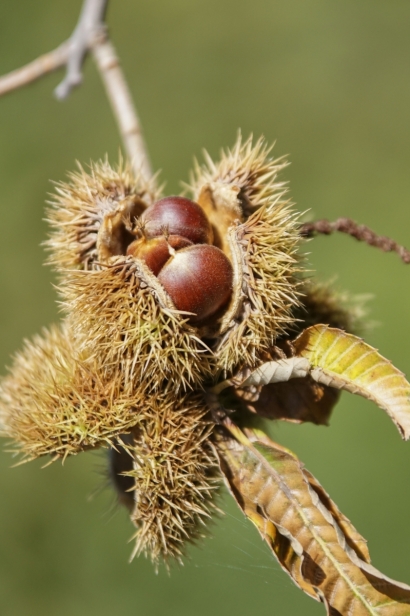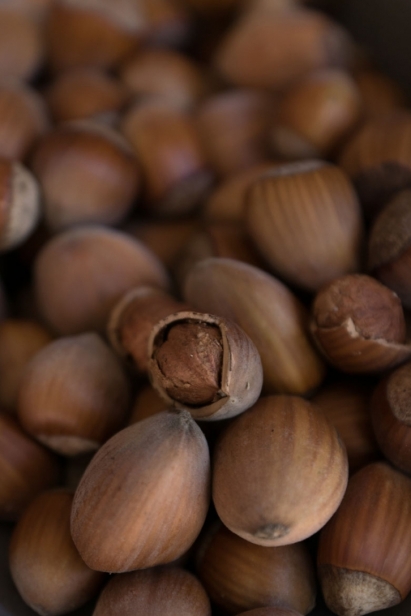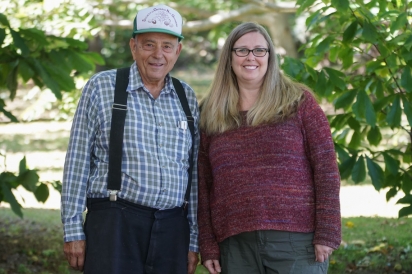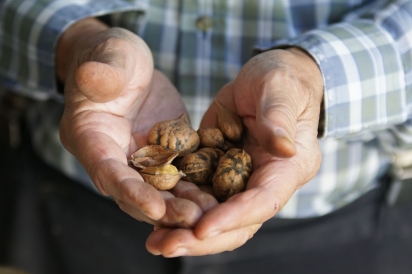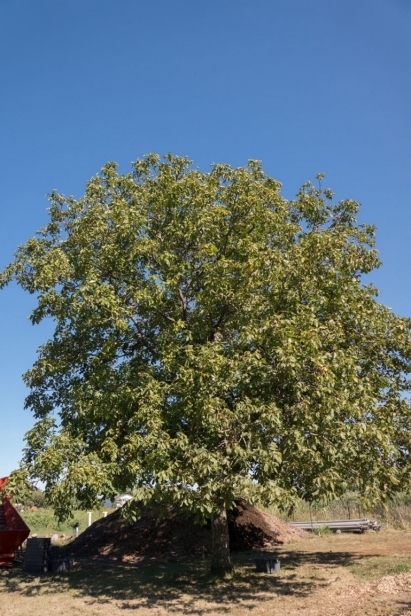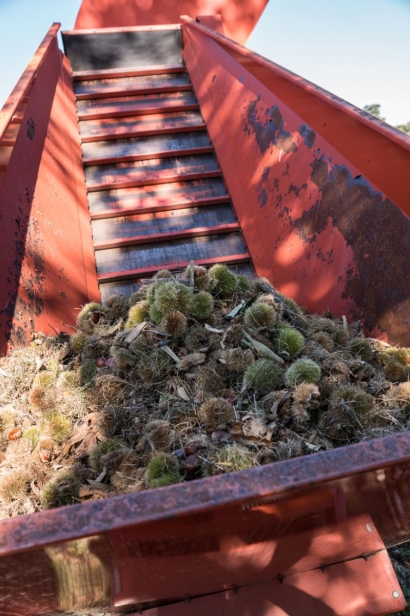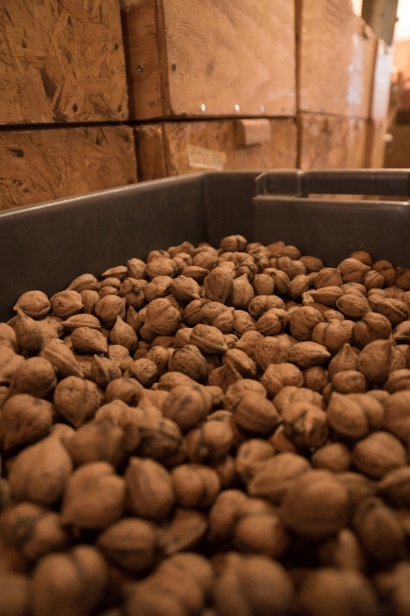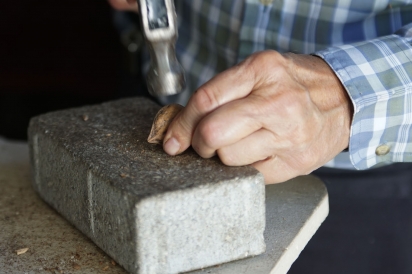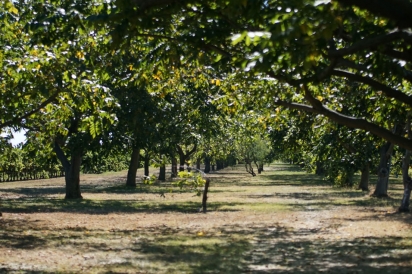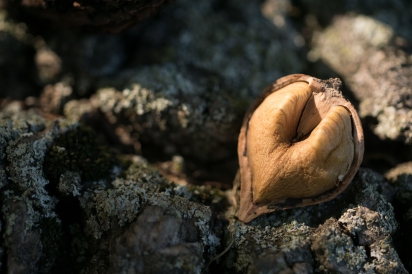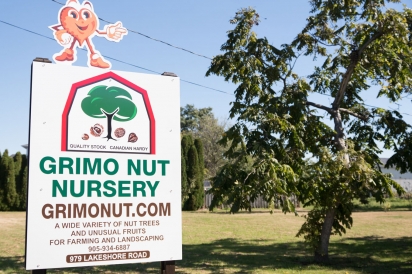Crazy for Ontario-Grown Nuts
You could call Ernie Grimo Canada’s Johnny Appleseed of nuts. He went from passionate hobbyist to nut grower over the past 50 years, juggling a farm and tree nursery business with teaching primary grades in Niagara.
Now 78, Grimo has been growing, researching, improving, selling and enjoying nut trees all this time. He sees a bright future in establishing a potentially profitable crop for Ontario farmers: hazelnuts.
It started as a hobby. But as everybody knows, when it comes to nuts, you can’t stop at one.
“I wanted to grow walnuts and of course, once I got a walnut tree, then I wanted to grow all the other ones,” he says. “I wanted the edible landscape all around the yard.”
The quarter-acre around the house grew to four acres. “The soil was terrible and there was only one patch that grew the (nut) trees successfully,” Grimo recalls.
In 1974, he and his late wife, Marion, bought an 11-acre farm in Niagara-on-the-Lake. It’s since expanded to 14 acres.
The hobby quickly became a vocation with the opening of Grimo Nut Nursery the same year, a business that’s expanded to growing varieties from hazelnuts to heartnuts, along with producing cultivars, seeds and trees. He sells them locally and ships to most provinces and much of the U.S. Midwest and colder-climate states.
Daughter Linda Grimo, 48, one of Ernie and Marion’s four children and also a former teacher, joined the business in 1999. After Marion’s death in 2010, Grimo married Bernice, who works on the farm in sales.
Like folklore’s Appleseed, Grimo wanted to share his knowledge and get others to grow bountiful trees. That included kids, thanks to the 10,000 hazelnut seeds he has donated to area schools over the past 50 years.
He developed a program to use nuts as a teaching tool in his Grade 4 and 5 classes, captivating the kids from the start by explaining there’s “a tiny plant” inside the seed. “They would learn to grow a tree and learn what the requirements are to get a tree to grow and plant them in their parents’ backyard.”
As to how many hazelnut trees are growing in Niagara yards from these hands-on lessons, Grimo can’t say.
He’s been breeding hazelnut varieties for more than 40 years. And although it’s tough market to crack, Grimo and the Ontario Hazelnut Association see profit in developing an industry around the two-tone nuts.
Also known as filberts, the heart-healthy nuts are delicious toasted and tossed into salads or crusted on pan-seared fish. They’re the star of buttery praline and chocolate’s soulmate in luscious Italian Gianduja.
Some prefer to grab a handful and snack, a demand Grimo finds challenging to meet. “We get people that drive two hours from Toronto to get nuts and we can’t meet the demand of people are already coming,” he says.
And then there are those who get their hazelnut fix from the chocolaty Nutella spread.
That’s where international brand the Ferrero Group comes in, a global industry that uses 60 per cent of the world’s hazelnut production to make Ferrero Rocher confections and Nutella.
Most of its hazelnuts come from Turkey and Italy. But at Ferrero Canada’s 900,000-square-foot production plant, opened in 2006 in Brantford, Ont., there’s an interest in supporting local hazelnut growers. The company has announced plans to implement 100-per-cent traceability of all hazelnuts used by 2020.
According to farms.com, Ferrero imports more than 11,000 tonnes of hazelnut yearly at the Brantford plant.
“They’re helping to build the entire industry,” says Grimo, one who stands to gain “tremendously” from the relationship.
He said Ferrero is eager to establish an Ontario crop, which could mean “unheard of” contracts stretching 10 years or more.
He and Linda are active in local nut growers’ groups, including the Ontario Hazelnut Association. Members are working with the University of Guelph and its Simcoe Research Station to educate farmers thinking of switching crops with orchard tours and information seminars.
Hazelnuts are suited to grape and tender fruit-growing regions of the province, anywhere in zones 4 to 7. Ferrero’s aim is to form a network of growers by researching the best variety of Ontariogrown, disease-resistant hazelnut tree that meets the company’s flavour-profile needs. To that end, a portion of the two to three tonnes of hazelnuts now grown annually on 300 acres scattered across Ontario farms is sold to Ferrero for research purposes.
“Ferrero has worked with the industry in such a positive way, we see it as a win-win,” Linda says. The research investment benefits the company and the market for larger fresh nuts that don’t meet Ferrero’s requirements.
“Grocery stores will someday carry Ontario hazelnuts as a result of the contributions Ferrero has made to support the entire hazelnut-growing industry,” she adds, pointing out smaller, niche-market sellers can get a higher price per pound by selling to local consumers and markets.
Les High of Highview Orchards, near Jordan Station, is among the newcomers to hazelnut farming. At 65, he’s technically retired, but in reality, far from it. A former tender-fruit grower, he removed his trees and planted his first hazelnuts in 2011. He sells most of his crop to Ferrero for its trials.
High also comes from a nut-growing background. His father had planted hazelnuts and his father-in-law was “a walnut connoisseur; he had some very good varietals.”
“They’re not a commercial crop yet,” he says of the hazelnuts. “Looking down the road 10 years from now, that could change.”
Beyond Ferrero, Ontario hazelnuts could find markets elsewhere, including confectionary companies, bakeries and fresh markets. Other uses include oils and flavourings. And then there’s beer.
Niagara Oast House Brewers in Niagara-on-the-Lake buys Grimo’s nuts for two popular seasonal brews in its Rural Route series saluting Niagara-region products.
Roasted Chestnut Brown Ale, made from Grimo’s chestnuts that are double-roasted at the brewery, is a top seller. And Grimo’s walnuts are the star attraction in Toasted Walnut Bourbon Barrel-Aged Porter. “Hazelnuts are definitely on our radar,” says brewmaster Mike Pentesco.
Meanwhile, High’s hazelnut trees are finally maturing. Last year was his first significant yield, about 340 kilograms. Beyond what went to Ferrero, he sold to small businesses including local fruit and vegetable stores, an oil and flavouring maker, a baker and Fergus nut farmers and roasters, Jewels Under the Kilt.
He says tastes have changed. The bowl of nuts in the shell and a cracker are seen less often today. “People want to open a bag.”
High is also a member of the Hazelnut Growers and says there is interest among farmers curious about making the switch to nuts.
It’s tempting for the cash-crop farmers, he says, because nut trees are perennial. For fruit-growers, the trees require less maintenance, as research has led to varieties that are more resistant to common diseases. There’s no need to invest in expensive harvesting machinery. Most of the work is done by hand and the trees tend to be short and squat. “You don’t have to prune (trees) much. One person can manage 10 to 20 acres easily without having added labour, even to harvest,” Grimo adds.
The downside is the four to five years to wait for a yield. Expect it to be even longer to get a substantial harvest. But patience is rewarded. A tree can bear nuts for 100 years.
Meanwhile, Grimo’s curiosity about new varieties of crops has led to growing heartnuts. “They are Ernie’s legacy,” his daughter says proudly. “He’s brought it to light more than anyone in North America.”
Grimo Nut Nursery sells heartnut grafts and seedlings. A cousin of the Japanese walnut, the rock-hard shell contains a heartshaped kernel. Crafters love the two elongated heart-shaped halves left when the nut is released and Grimo is working on a genetically stable heartnut that will have the ideal shape for cracking, easily releasing the intact nut.
Linda describes the taste as mild, “like a walnut without the bitter aftertaste,” with a creamy, cashew-like texture.
“It makes wonderful butter and I like it better than peanut butter,” she says. Heartnuts are available at the farm after Thanksgiving. The real challenge is getting them open. Nutcrackers won’t cut it. Linda joked the best method is with a hammer and a brick, although the Ontario Society of Nut Growers is working with Niagara College to develop an efficient industrial cracker.
So how do nut farmers like to eat their product? High likes to slow-roast shelled hazelnuts in a toaster oven. After 10 minutes on a low heat, he’s got a healthy snack, or a topping for cereal or salad.
Grimo’s favourite nut is the shellbark hickory. “He keeps a secret stash of them in the freezer to make sure he gets some before they are sold,” Linda says.
Her favourites vary by the season; from heartnut butter to chestnuts for her holiday turkey stuffing. In winter, black walnuts go into salads, fruit and yogurt or a pan of fudge.
“People who have been in Canada for a number of years have forgotten the value of eating off the land,” Grimo says. “We eat them straight off the tree.”
Grimo Nut Nursery
979 Lakeshore Rd., Niagara-on-the-Lake
grimonut.com, 905.934.6887



